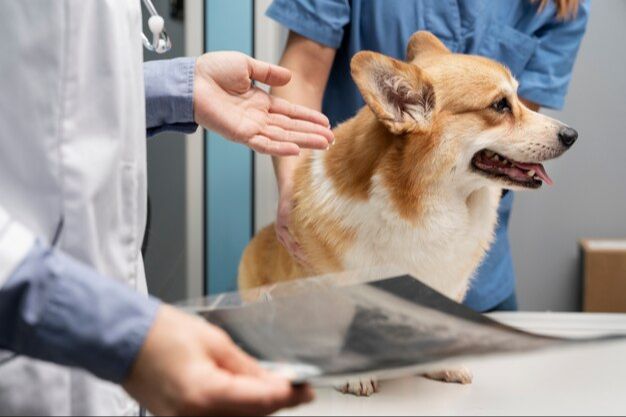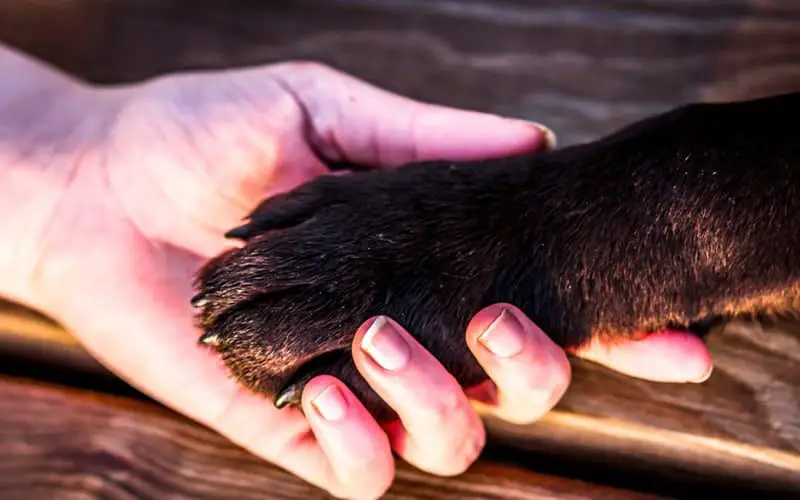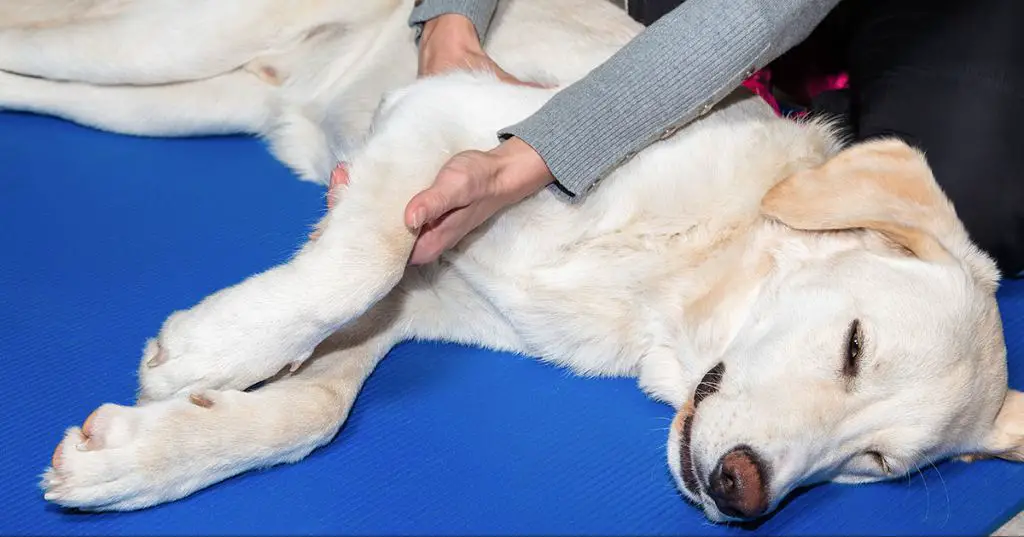Why Your Dog Flinches When You Touch Their Paws
If your normally friendly and docile dog suddenly becomes anxious or defensive when you touch their paws, it can be surprising and concerning. You may start to worry that they’re becoming aggressive or that something is seriously wrong. However, there are many potential reasons why dogs flinch or pull away when their paws are handled that don’t necessarily mean anything is wrong with their behavior.
From simple sensitivity to more serious medical issues, understanding the possible causes can help you determine if your dog’s reaction to paw touching requires a vet visit. With care and patience, you can identify the source of the sensitivity, and help your dog become comfortable with paw handling once again.
Possible Causes
If your dog flinches when their paws are touched, it could be a sign of past physical trauma or abuse. Dogs have very sensitive paws, and repeated trauma to this area can cause lasting pain and fear. If your dog cowers or acts anxious when their paws are handled, they may have learned this reaction after being subjected to harsh discipline or mistreatment as a puppy. The paws are vulnerable areas for dogs, and abusive behaviors like hitting, kicking or stepping on paws can lead to fearful reactions later in life. Even if you adopted your dog after puppyhood, these negative associations with paw handling can persist. Other signs of past abuse may include aggression, destructive behaviors or excessive submissive urination. While the damage cannot be undone, counterconditioning with positive reinforcement can help traumatized dogs overcome their fears. Consult an animal behaviorist for customized desensitization techniques. With time, patience and compassion, you may be able to help your dog gain confidence and feel relaxed with paw handling once again.

Overly Sensitive Paws
Some dogs simply have more sensitive paws than others. Things like texture, temperature, and friction can cause discomfort when their paws are touched. Dogs with thinner fur on their paw pads and between their toes tend to be more sensitive. Their paws may also be extra sensitive due to allergies or irritants. If your dog has always reacted when their paws are handled, they may just be a sensitive pup.
Look for signs like flinching, pulling paws away, licking paws excessively, or whimpering only during paw handling. If your dog is otherwise comfortable and content, sensitive paw pads are likely the culprit. Try to gradually desensitize them to paw handling with positive reinforcement and treats. Go slow and keep sessions short to avoid overwhelming their senses.
Arthritis or Joint Pain
Arthritis is a common cause of paw sensitivity in dogs. Just like in humans, arthritis causes inflammation, swelling and joint pain. The joints in a dog’s legs and paws are prone to arthritis, especially as they age. Signs that your dog may have arthritis include:
- Limping or favoring a leg
- Difficulty standing up, walking or jumping
- Crying out in pain when touched or moved
- Sensitivity and flinching when paws are handled
- Licking or chewing their joints
Arthritis usually develops gradually over time. It’s caused by wear and tear on the joints from age, injury, obesity or genetic factors. If your dog is flinching when their paws are touched, it’s a good idea to have them examined by a vet. X-rays or joint fluid tests can confirm arthritis. Treating the underlying arthritis with medication, joint supplements or therapy can help reduce paw sensitivity and pain.

Nail or Paw Injuries
Dogs can experience various types of nail and paw injuries that may make them flinch when their paws are touched. Common injuries include cracked or broken nails, torn nail beds, splinters stuck in the paws, cuts on the pads, and abscesses between the toes or pads. These injuries are often quite painful and very sensitive to the touch. Dogs may limp or lick excessively at injured paws.
Nail and pad injuries generally happen when dogs are playing or running on rough surfaces. Stepping on a sharp object like a thorn, rock, or piece of glass can easily cut into the tender paw pads and toes. Long toenails are more prone to cracking or tearing. Hard impacts on rough surfaces can also cause bruised nails or nail bed injuries.
It’s important to check your dog’s paws regularly and trim excess nail length to help prevent injuries. If you notice limping, licking, flinching, or visible cuts or cracks to the nails or pads, promptly clean the area and apply antiseptic. Protect further irritation by keeping your dog off hard surfaces while healing. Seek veterinary care for deep pad lacerations, persistent limping, or nail injuries involving significant bleeding or detachment.
Signs Your Dog is in Pain
If your dog is flinching or sensitive when you touch their paws, it’s a clear sign they are experiencing some discomfort or pain. Here are some behaviors that may indicate your dog’s paws are hurting:
- Whimpering or yelping when their paws are handled or touched
- Aggressive behavior like growling or snapping when you touch their paws
- Limping or holding one paw up
- Licking and chewing at their paws excessively
- Avoiding walking or sudden lameness
One of the most obvious signs your dog is in pain is if they cry out, whine or yelp when you touch their paws. If they are sensitive or sore, the pressure from you touching their paws likely aggravates the pain. Pay close attention to any vocalizations of discomfort when you handle their feet.
Aggression when paws handled
One of the most common signs your dog’s paws are causing them pain or discomfort is if they show aggression or try to bite when you touch their paws. Dogs typically don’t like having their paws handled in general, but normally don’t react with aggressive behavior.

If your dog is fine with you touching the rest of their body but reacts aggressively when you touch their paws, that’s a clear indicator there’s some type of pain or sensitivity localized to their feet. They may growl, snarl, snap, or attempt to bite when their paws are handled because it causes discomfort.
Dogs in pain will often provide warning signs before biting, such as growling or freezing up. It’s important not to punish them for these warnings, as that can make the aggression worse. If your dog does snap or bite when their paws are touched, gently let go and don’t continue examining their paws to avoid further bites.
Aggressive reactions to paw handling in an otherwise friendly dog are a sure sign there is some underlying physical issue causing them pain. It’s best to avoid touching their paws until the sensitivity can be addressed by a veterinarian.
When to See the Vet
You should schedule a vet appointment right away if your dog is showing any signs of limping, infections, or wounds on their paws. Limping or favoring one paw over another could signal an injury or condition like arthritis that requires veterinary attention. Open wounds or red, inflamed areas may point to an infection that needs medication. Your vet can check for foreign objects lodged in the paws as well. Don’t try to treat open wounds at home, as they require proper cleaning and medication under veterinary supervision.
Even without visible wounds, if your dog frequently licks at their paws, holds them up, or refuses to walk on a certain surface, a vet visit is in order. These behaviors likely indicate discomfort that should be addressed. Your vet can rule out issues like allergies, arthritis and other orthopedic problems. They may recommend x-rays to check for fractures or arthritis in the joints. Bloodwork may help identify other potential causes of paw sensitivity like thyroid disease or Cushing’s disease.
If your dog is whimpering, crying or snapping when their paws are touched, see your vet promptly. While dogs naturally don’t like having their paws handled, pain responses like these are abnormal and need medical attention. Don’t delay in getting them assessed.
Treating Sensitive Paws
If your dog is experiencing sensitive paws, there are several at-home remedies you can try to help soothe their pain and discomfort.
Gentle massage can increase blood flow and relax muscles in dogs’ paws. Use light pressure and massage in circular motions for 5-10 minutes per paw. This may help relax cramped muscles or joints causing sensitivity.

Paw balms containing soothing ingredients like vitamin E oil, shea butter, and beeswax can also help moisturize and protect sensitive paw pads. Apply balm liberally before walks. Musher’s Secret and Natural Dog Company’s Paw Soother are top options.
Booties are another great option, especially for dogs who react painfully to hot pavement or icy, salted sidewalks. They shield paws from irritants. Introduce booties slowly with treats and praise so your dog accepts them.
By massaging paws gently, using paw balms, and trying booties, you can help comfort your dog’s sensitive feet at home. But if symptoms persist or worsen, consult your vet to address the underlying cause.
Preventing Future Issues
There are some steps you can take to help prevent your dog from developing sensitive paws in the future:
Avoid Rough Terrain
Try to avoid having your dog walk for long periods on concrete, asphalt, gravel, or other rough surfaces that can irritate their paw pads. Opt for grass, dirt trails, or other softer ground when possible.
Check Paws Regularly
Get in the habit of inspecting your dog’s paws on a regular basis. Look for any cuts, cracks, foreign objects, inflammation or other signs of irritation. Address any issues promptly to prevent further pain and sensitivity.
Keeping your dog’s paws healthy and callus-free will make them less prone to injury and irritation over time. Letting injuries fully heal before extensive walks will also prevent exacerbating any sensitivity.
Conclusion
In conclusion, if your dog flinches or shows signs of discomfort when their paws are touched, it can point to several underlying causes. Sensitivity could stem from injuries, arthritis, or other sources of pain in the paws or joints. Observe your dog closely to pinpoint the triggers and consult your vet if the reaction seems abnormal or excessive. With some patience and care, you can likely identify the source of irritation and find ways to manage your dog’s sensitive paws.
By understanding why your dog’s paws are sensitive and taking steps to minimize discomfort, you can help prevent more severe problems down the line. Approach their paws gently, keep their nails well-trimmed, and provide soft surfaces for them to walk on. Your vet may also recommend joint supplements or medication for arthritis. While sensitive paws require some extra attention, the condition is often manageable with simple at-home treatment.
Most importantly, be attentive to your dog’s needs and don’t force them into situations that clearly cause distress. With some small adjustments to their care routine and environment, you can keep their paws happy and healthy for years to come.